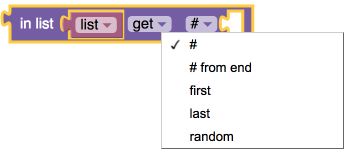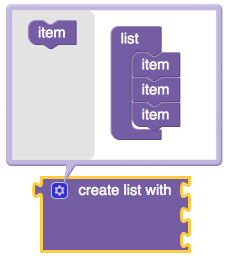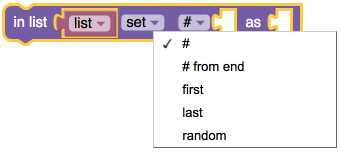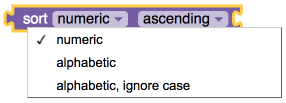Lists¶
| Block name |
Block rendering |
|
|---|---|---|
| Gets an object from a list. |
  |
|
| Gets an object's index in a list. |
 |
|
| Creates a list with an object. |
 |
|
| Gets list size. |
 |
|
| Checks if the list is empty. |
 |
|
| Creates a list with objects. |
 |
|
| Creates an empty list. |
 |
|
| Sets/inserts an object at index into a list. |
  |
|
| Gets a sublist from a list. |
 |
|
| Makes list from text or text from a list. |
 |
|
| Sorts list. |
 |
|
| Creates a collection consisting of objects accessible through the named property in the original collection. |
 |
If the original collection contains objects A, B and C and each object has property foo, the resulting collection contains values accessible via A.foo, B.foo and C.foo. |
| Deletes a value from the list. |
 |
The value of the item property can be of any valid JSON type, and it expects a value that must be deleted from the list.The comparator property is only used when a list contains two or more objects whose keys are identical, for instance [{"foo":1}, {"bar":2}, {"bar":3}]. In that case, if you want to delete the object {"bar":3} you have to pass the key name "bar" to the comparator property and specify the value 3 in the item property. While key values of objects are identical, you instruct the operation to delete a specific object by specifying the key and the value. |
| Replaces a value in the list. |
 |
The value of the item property can be of any valid JSON type, and it expects a value that is used to replace another value in the list.The comparator property is used when a list contains two or more objects with a few properties in each object , for instance [{"id":1, "name":"Foo"}, {"id":2, "name":"Bar"}, {"id":3 , "name":"Buzz"}]. In that case, if you want to replace the object {"id":2, "name":"Bar"} you have to pass the key name "id" to the comparator property and specify a new object {"id":2, "name":"John"} that will replace the {"id":2, "name":"Bar"} object.The example above uses the value 2 of the "id" key of the new object to find an existing object with the same value stored in the list, and then it replaces the current object with a new one. |